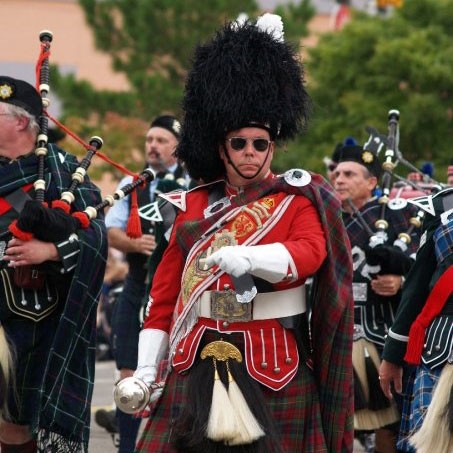When it comes to the University of Oklahoma’s graduation ceremonies, nothing carries the same pomp and circumstance as a band of bagpipe players.
Not a crew of clarinetists, a fleet of flautists nor a troupe of trumpeters will do for OU. It’s got to be the Highlanders of Oklahoma City, a pipe and drum band that’s escorted OU President David L. Boren into the Oklahoma Memorial Stadium before each graduation ceremony for nearly 20 years.
The tradition goes back a couple decades at OU, but the history of bagpipes spans a millenium. Ask a historian or even a bagpipe know-it-all where the instrument originated and when, and you might get a “who the heck knows.” Could be Egypt. Could be Ethiopia. The instrument evolved so much throughout the years that it's still difficult to decipher its exact timeline.
It’s much easier to talk definitively about the instruments and their role in the early 1900s and beyond.
“The bagpipes were an instrument of war,” said Robert Bruce, business manager, pipes major and director of music for the Highlanders of Oklahoma City. “All militaries had something to scare away the opponent, whether it was a war whoop or drums or stampeding horses. The British had the bagpipes, whose sound was kind of daunting to the opponents.”
Just the layout of a bagpipe is enough to send some people running in the other direction. Here’s what a player of the Great Highland bagpipe is working with:
- 4 reeds
- 1 air supply: The player blows into this piece to fill the bag with air
- 1 bag: This might be made of sheep, cow or goat skin
- 1 chanter: The player creates different notes by covering the chanter’s holes with his fingers
- 3 drones: The Highlanders’ bagpipes have a bass drone and two tenor drones. These tubes on the top of the instrument create a constant harmonizing note throughout play.
That’s a lot to think about for a musician. In Bruce’s words: “We have to blow, finger and squeeze all at the same time.” (We love this bagpipe rundown from the BBC if you're looking to learn more.)
And the notes a bagpipe can play span only one octave. If you’re not a music person, think about it like this: A skilled saxophone player can play three octaves and a pianist can play eight. With only one octave — and no sharps and flats, to boot — the bagpipe player has to be choosy about which songs he plays. The small range of notes won’t allow for just anything.
“Here’s one we’ve been asked several times to play and I had to turn it down: 'The Star Spangled Banner,'” said Bruce, 69, of Midwest City. “We cannot play 'The Star Spangled Banner,' and I’m not going to murder our national anthem.”
It’s a pity you’ll never hear the Highlanders of Oklahoma City usher in the Oklahoma City Energy FC soccer players or kick off a game for the Thunder inside Chesapeake Energy Arena. But, fortunately for the University of Oklahoma, the bagpipe is perfectly suited for one of our personal favorites, the OU Fight Song “Boomer Sooner.”
In the Highlanders’ repertoire you’ll also find familiar hymns as well as a mix of traditional Scottish and Irish tunes, including “Greensleeves,” “Yankee Doodle,” “Amazing Grace,” “America the Beautiful” and “Auld Lang Syne.” In fact, the group has more than 40 songs on heavy rotation.
The group, with male and female members from teens to those in their golden years, has been playing parades, funerals and other events since 1957. They've had their share of special performances, having opened for the likes of Rolling Stones frontman Mick Jagger, who’s been known to tap local bagpipe bands to share the stage with him.
Now, the Highlanders prepare to head into their busiest month yet, performing at several of the university’s graduations, including the main ceremony at 7 p.m. May 8. It’s an OU tradition that they hope to continue for years to come.
"For 20 years the Highland Pipes and Drums have been a very important part of the commencement ceremonies at the University of Oklahoma," Boren said. "The bagpipe music and the flair with which they present it adds a special spirit to the entire occasion. They are a real treasure for our state."
Bruce said it’s not an easy thing to master the bagpipe. It takes stamina and practice — lots and lots of practice. He offered his advice to those wanting to excel at something they love doing, words of wisdom particularly apt for those Sooners graduating from the University of Oklahoma in May 2015.
“Whatever you put in it, that’s what you’re going to get out of it,” Bruce said. “That’s not just with music; that’s anything in life. In anything you do, if you put 110 into it, you will get 150 back out.”
Are you going to OU’s commencement ceremony? Instagram and tweet your photos — especially those of the Highlanders of Oklahoma City and your decorated graduation caps — using the hashtag #OUGrad15!



